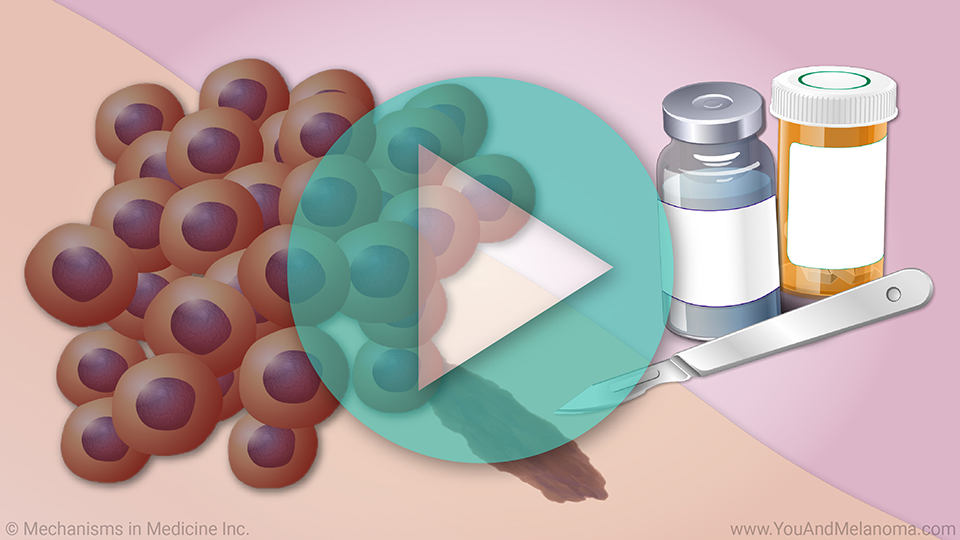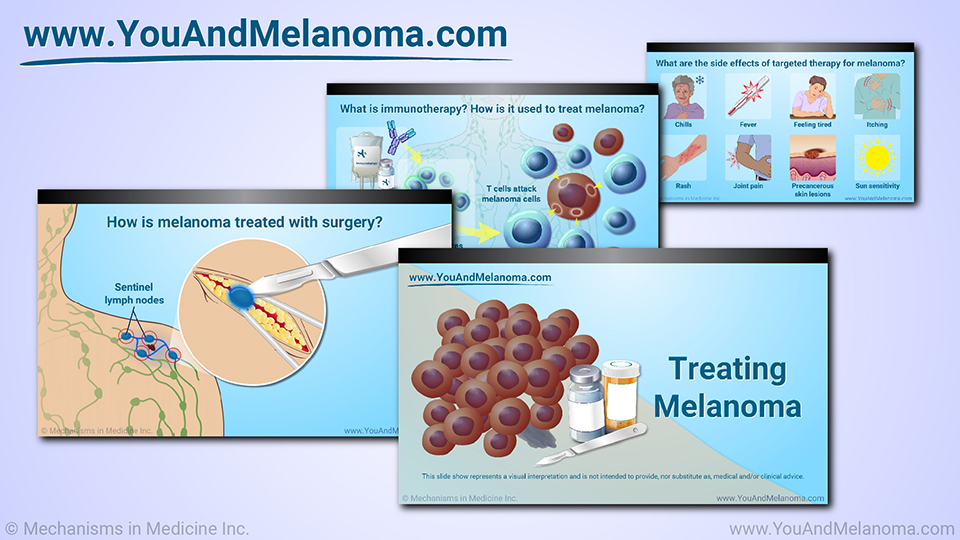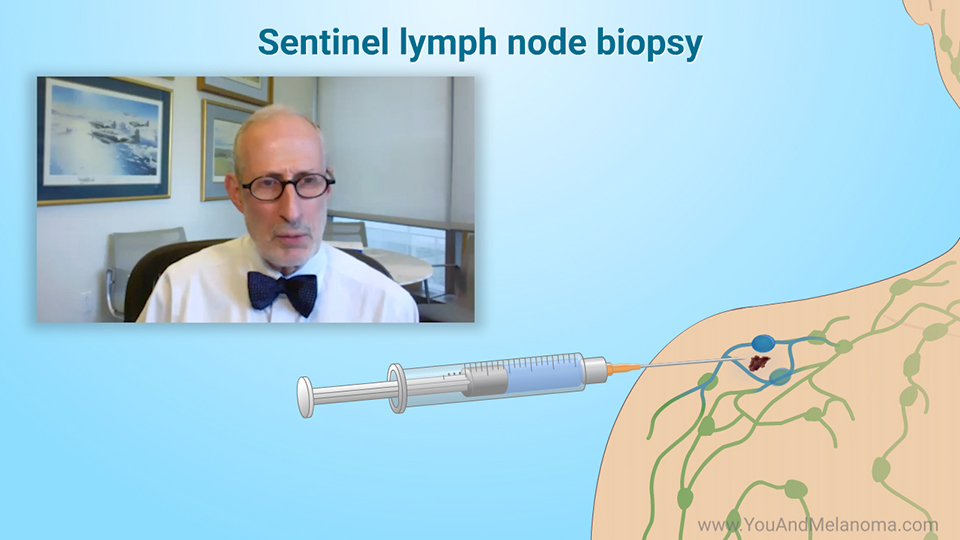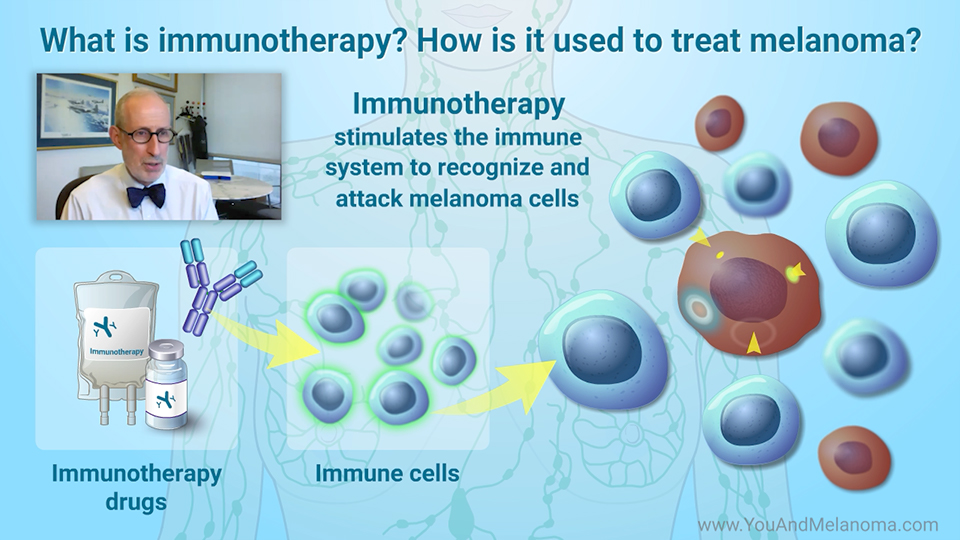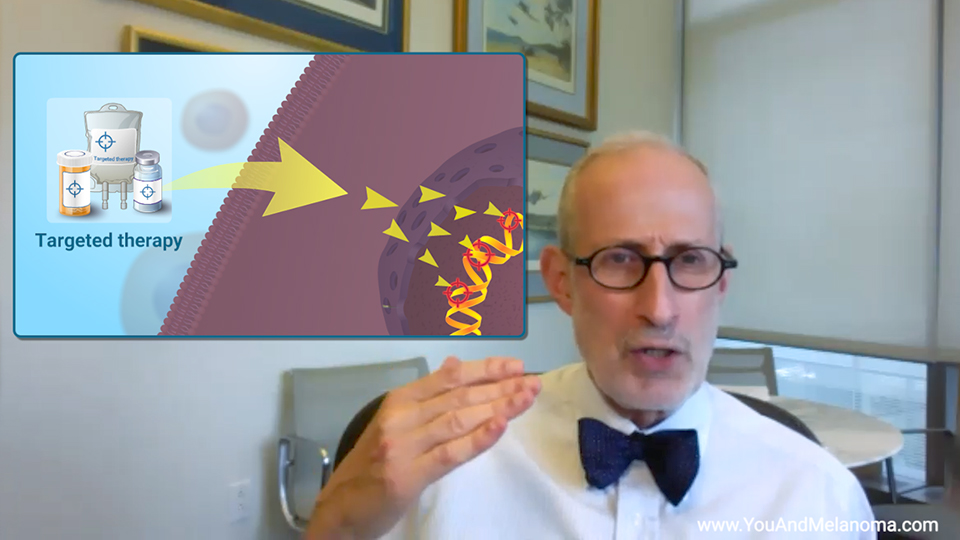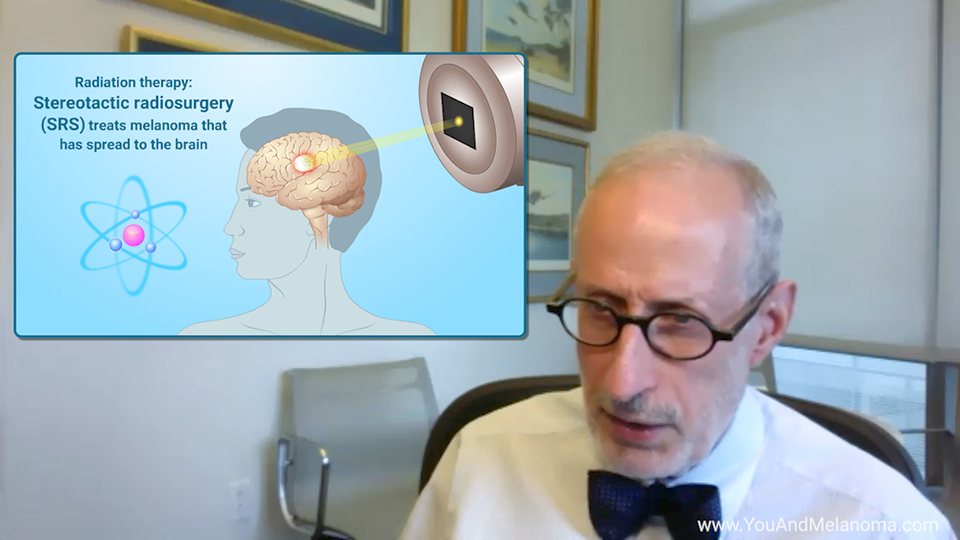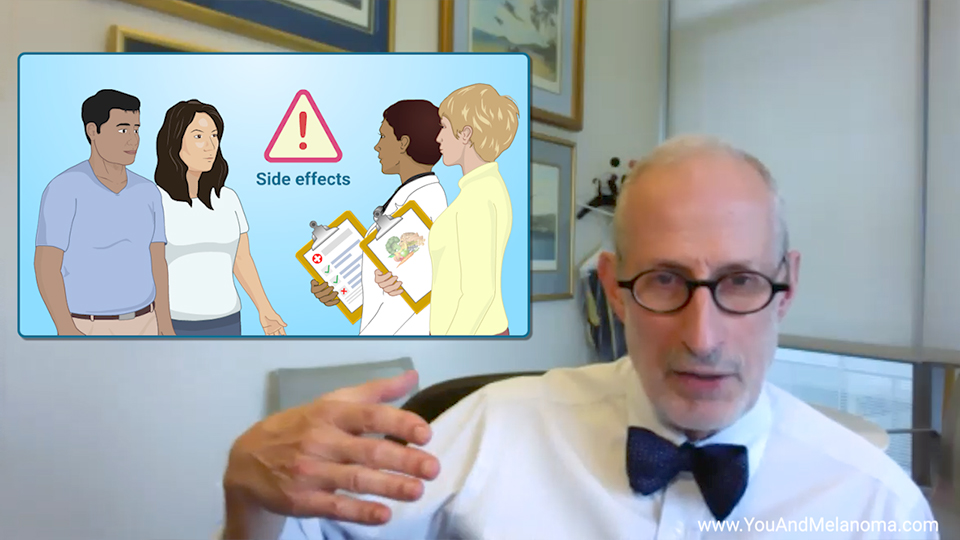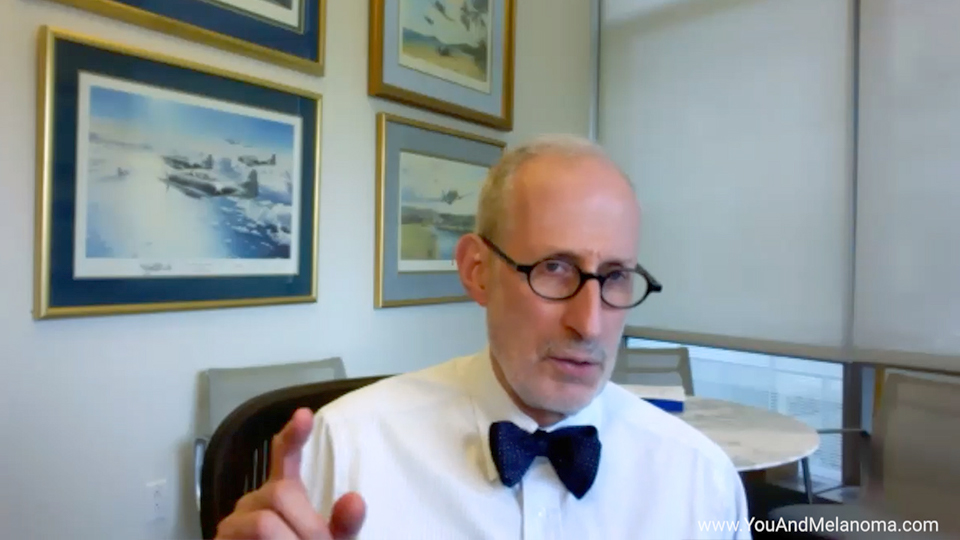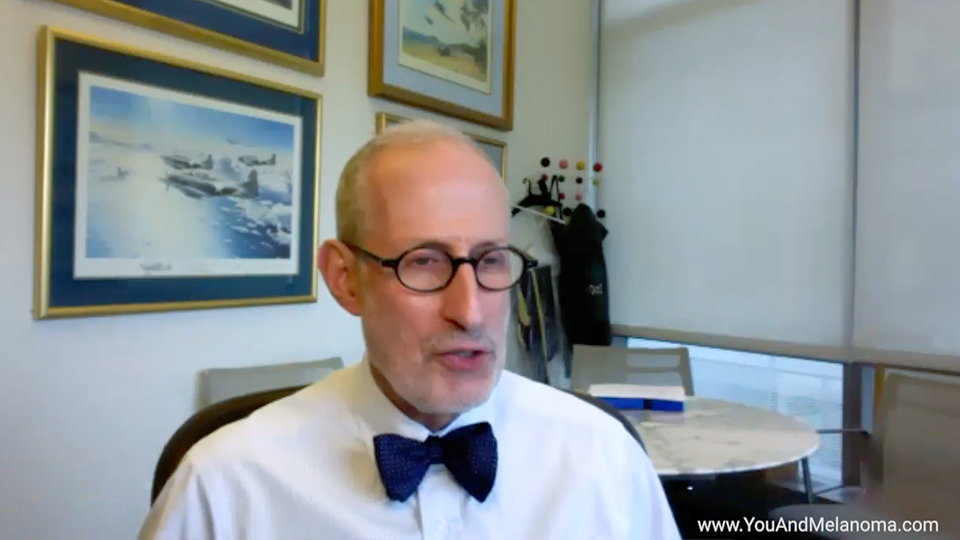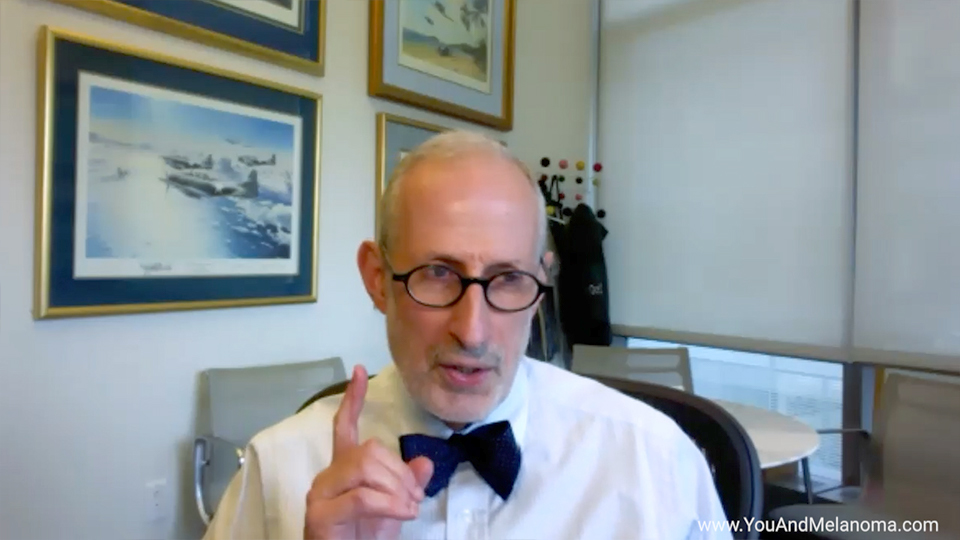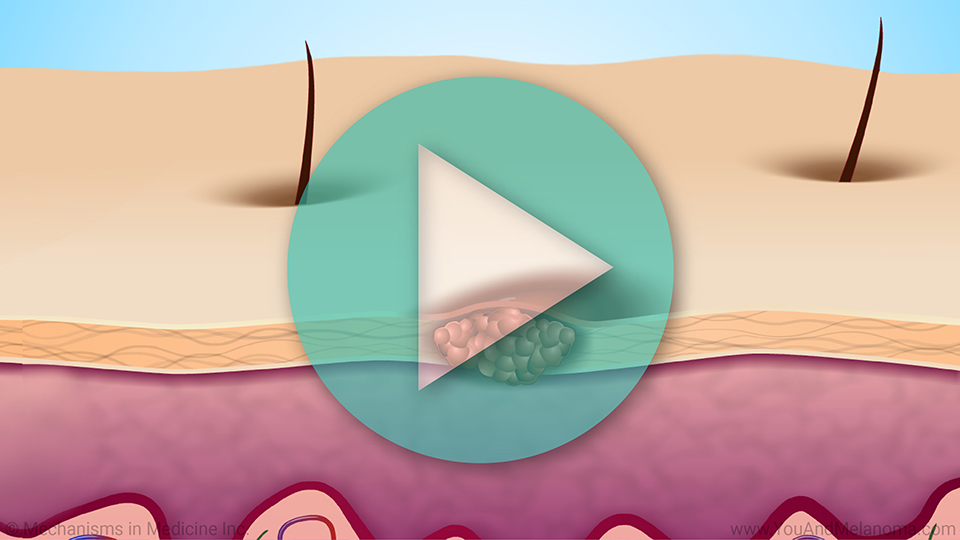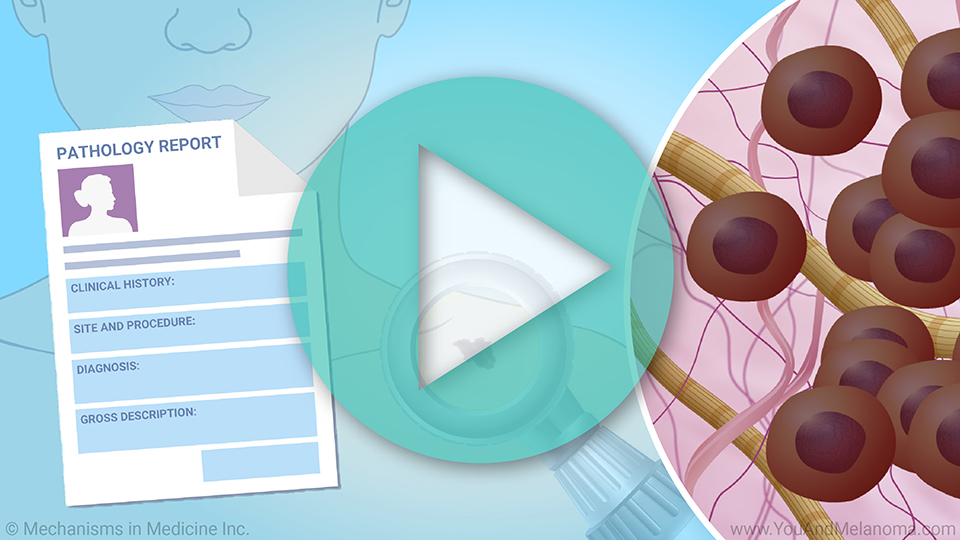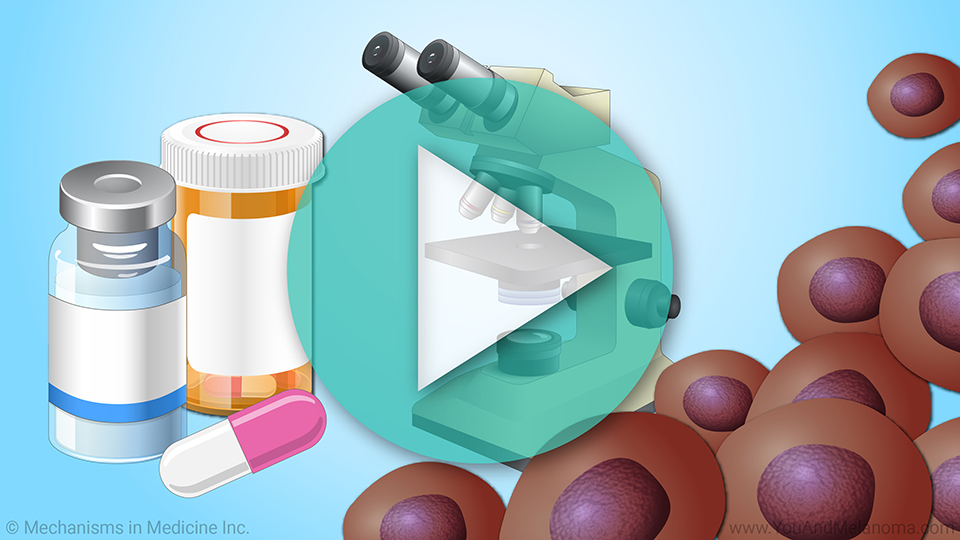Treating Melanoma
*Please note: This slide show represents a visual interpretation and is not intended to provide, nor substitute as, medical and/or clinical advice.
How is melanoma treated with surgery?
Surgery to remove the tumor is the standard treatment for early-stage melanoma. The procedure is called a
wide local excision.
The surgeon cuts out the tumor as well as some normal skin around the tumor's edges. This is called the margin.
How is melanoma treated with surgery?
Sometimes the surgeon will do a sentinel lymph node biopsy first to see if melanoma has spread to lymph nodes near the tumor.
Sentinel lymph nodes are the ones that melanoma is likely to spread to first.
If cancer is found in the nodes and the sentinel nodes are enlarged, the surgeon will remove all the lymph nodes near the tumor.
Otherwise, the surgeon will remove just the sentinel nodes.
What are the risks of surgery for melanoma?
Surgery may cause side effects such as bruising, scarring, and short-term pain and swelling.
Surgery to remove lymph nodes may cause swelling, or lymphedema, at the site where the nodes were removed. In some cases, this might be permanent.
Lymphedema may cause discomfort, skin redness, and stiffness in nearby joints. Tell your doctor if you have lymphedema. Treatment can help.
What is immunotherapy? How is it used to treat melanoma?
Immunotherapy uses the body's immune system to fight cancer.
Unlike chemotherapy, immunotherapy does not kill cancer cells directly. Instead, it stimulates the immune system to recognize and attack the cancer cells.
Immunotherapy is a kind of precision medicine, treatment that is tailored to the individual features of your cancer.
What is immunotherapy? How is it used to treat melanoma?
Checkpoint inhibitors are one type of immunotherapy.
Inside cancer cells are proteins that "put the brakes" on the immune system. These proteins act as "checkpoints" that stop the immune system from attacking the cancer.
Checkpoint inhibitors are drugs that "take off the brakes" and allow the immune system to release special cells called T cells to attack the cancer.
What is immunotherapy? How is it used to treat melanoma?
In melanoma, checkpoint inhibitors block proteins called PD-1 and CTLA-4.
Several other kinds of immunotherapy drugs may also be used to treat melanoma.
What are the side effects of immunotherapy for melanoma?
The side effects of immunotherapy may include flu-like symptoms, diarrhea, fever, feeling tired, and gaining weight.
What is targeted therapy? How is it used to treat melanoma?
Targeted therapy uses drugs to attack substances produced because of abnormal genes in the melanoma tumor.
Like immunotherapy, targeted therapy is a kind of precision medicine.
What is targeted therapy? How is it used to treat melanoma?
About six of every 10 patients with advanced melanoma have a change in a gene called BRAF. Some others, especially if the melanoma starts in the mucous membranes, have a change in a gene called C-KIT.
Your doctor should test your tumor to see if it has these changes. This will help the doctor decide what treatment might work best for you.
What are the side effects of targeted therapy for melanoma?
The side effects of targeted therapy may include chills, fever, feeling tired, itching, rash, joint pain, development of new precancerous skin lesions and extreme sensitivity to the sun.
Can I be treated for melanoma with radiation therapy?
Radiation therapy may be used to treat melanoma symptoms.
A type of radiation therapy called SRS may be used to treat melanoma that has spread to the brain. SRS uses special equipment to precisely deliver a single large dose of radiation.
What are the side effects of radiation therapy for melanoma?
The side effects of radiation therapy may include swelling, body aches, feeling tired, and skin burning and other skin changes. You may also be at higher risk for getting a second cancer.
Can I be treated for melanoma with chemotherapy?
Chemotherapy is rarely used for melanoma now that newer treatments have been developed.
What are cancer vaccines? Can I be treated for melanoma with a vaccine?
Vaccines for cancer, including melanoma, are a type of immunotherapy. The idea is to stimulate the immune system to recognize and kill cancer cells before they form a tumor.
Vaccines for melanoma are being tested in clinical trials. As yet no vaccine has been approved to treat melanoma.
Ask your doctor if enrolling in a clinical trial of a melanoma vaccine might be right for you.
Can I get help to cope with melanoma treatment?
Be sure to talk with your health care team about any treatment side effects you are having. Many side effects can be treated or avoided.
A dietitian may be able to help you keep a healthy diet while you are being treated for melanoma.
It’s normal to sometimes feel sad or anxious after a melanoma diagnosis. Speaking with a counselor may help.
References
- How is Melanoma of the Skin Treated? Melanoma Research Foundation. https://melanoma.org/patients-caregivers/cutaneous-melanoma/treatment-cutaneous/
- Immunotherapy for Melanoma Skin Cancer. American Cancer Society. https://www.cancer.org/cancer/melanoma-skin-cancer/treating/immunotherapy.html
- Melanoma. NCCN Guidelines for Patients. National Comprehensive Cancer Network. https://www.nccn.org/patients/guidelines/cancers.aspx
- NCI Dictionary of Cancer Terms. https://www.cancer.gov/publications/dictionaries/cancer-terms
- Treating Melanoma Skin Cancer. American Cancer Society. https://www.cancer.org/cancer/melanoma-skin-cancer/treating.html
- Tan WW. Malignant Melanoma Treatment & Management. Updated Jan 31, 2020. https://emedicine.medscape.com/article/280245-treatment#d9
- What Is Lymphedema? American Cancer Society. https://www.cancer.org/treatment/treatments-and-side-effects/physical-side-effects/lymphedema/what-is-lymphedema.html
This slide show explains the current
treatment options for
melanoma. You can find out about
surgery (wide local excision, sentinel lymph node biopsy),
immunotherapy,
targeted therapy,
radiation therapy,
chemotherapy,
vaccines for melanoma, and
clinical trials. This slide show also describes possible treatment side effects. It's important to discuss all treatment options with your doctor or cancer care team, so you can make the best decisions that are right for you.
-
Share with family and friends:
Click here to take our SURVEY
Your feedback is important to us! We will use your feedback to develop future areas of content about melanoma which will help other patients, caregivers, and families.
